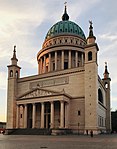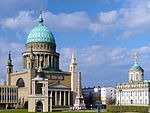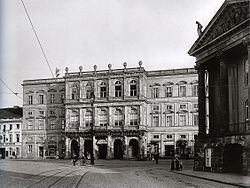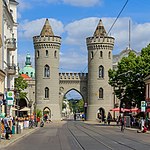Eight Corners

Acht Ecken (Eight Corners) is the name of a former architectural ensemble in Potsdam, Germany. At the intersection of Schwertfegerstraße and Friedrich-Ebert-Straße, four identical baroque houses were built on the corner plots in 1771 by Bayreuth architect Carl von Gontard. Each building was designed with a concave facade towards the crossroads, resulting in eight corners in total. Today, only one of the four buildings is left. Friedrich-Ebert-Straße was turned into a wide traffic artery after World War II destructions, occupying the two eastern building sites. The southwestern property was rebuilt with a modern prefab concrete building in the 1960s.
Excerpt from the Wikipedia article Eight Corners (License: CC BY-SA 3.0, Authors, Images).Eight Corners
Friedrich-Ebert-Straße, Potsdam Historische Innenstadt
Geographical coordinates (GPS) Address Nearby Places Show on map
Geographical coordinates (GPS)
| Latitude | Longitude |
|---|---|
| N 52.396111111111 ° | E 13.058611111111 ° |
Address
Friedrich-Ebert-Straße 123
14467 Potsdam, Historische Innenstadt
Brandenburg, Germany
Open on Google Maps










